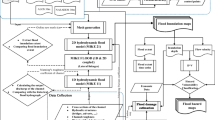Abstract
The development of an optimal scheme for evaluation of maximal water discharges is discussed, including adequate probability distribution laws, an effective procedure for their approximation based on observational data, and reliable goodness-of-fit tests for analytical and empirical distributions. One-dimensional probability distribution laws are systematized. Promising distributions were identified, including generalized distribution of extreme values, lognormal distribution, Pearson type V power distribution, and GPD, for evaluating maximal discharges. The available methods for approximating analytical curves, including the up-to-date method of L-moments are considered. Parameter estimation algorithm based on L-moment method for Pearson type III distribution is considered. Pearson type III distribution, lognormal distribution, GEV, and GPD are compared in the approximation of maximal water discharges in rivers of Austria, Siberia, Far East, and the Hawaiian Islands.
Similar content being viewed by others
References
Bolgov, M.V., and Pisarenko, V.F., The Distribution of Peak Runoff Values in Maritime Territory Rivers, Water Resour., 1999, vol. 26, no. 6, pp. 636–646.
Vinogradov, Yu.B., Matematicheskoe modelirovanie protsessov formirovaniya stoka (Mathematical Modeling Runoff Formation Processes), Leningrad: Gidrometeoizdat, 1988.
Gartsman, B.I. and Stepanova, M.V., Specific Aspects of Hydrological Calculations of Maximal Runoff in Far East, Geogr. Prir. Resur., 1996, no. 4, pp. 103–110.
Gartsman, B.I. and Bugaets, A.N., Application of a Model of Flood Cycle in a Small River Basin in Maximal-Runoff Calculations, in Gidrometeorologiya i ekologiya Dal’nego Vostoka (Hydrometeorology and Ecology of Far East), DVNIGMI Special Issue no. 4, Vladivostok: Dal’nauka, 2003, pp. 76–93.
Gartsman, B.I., Effect of Basin Counter-Regulation in the Formation of Extreme Rain Floods, Geogr. Prir. Resur., 2007, no. 1, pp. 14–21.
Gubareva, T.S., Statistical Regularities in Maximal Runoff in Amur Basin Rivers, in Analiz i stokhasticheskoe modelirovanie ekstremal’nogo stoka na rekakh Evrazii v usloviyakh izmeneniya klimata. Tr. mezh. Sem. (Analysis and Stochastic Modeling of Extreme Runoff in Eurasian Rivers under Changing Climate. Proc. Int. Workshop), Irkutsk: Izd. Instituta geografii SO RAN, 2004, pp. 182–191.
Naidenov, V.I., Shveikina, B.I., and Vikhrova, M.A., Probabilistic Regularities in Catastrophic Floodds, Meteorol. Gidrol., 2003, no. 6, pp. 81–95.
Naidenov, V.I., Nelineinaya dinamika poverkhnostnykh vod sushi (Nonlinear Dynamics of Continental Surface Water), Moscow: Nauka, 2004.
Rodkin, M.V., Typification of Catastrophic Manifestations of Natural Hazards, in Prirodnye opasnosti Rossii. T. 6. Otsenka i upravlenie prirodnymi riskami (Natural Hazards in Russia, vol. 6, Assessment and Control of Natural Risks), Moscow: KRUK, 2003, pp. 85–102.
Pisarenko, V.F., Bolgov, M.V., Osipova, H.V., and Rukavishnikova, T.A., Application of the Theory of Extreme Events to Problems of Approximating Probability Distributions of Water Flow Peaks, Water Resour., 2002, vol. 29, no. 6, pp. 593–604.
Ben-Zvi, A., and Azmov, B., Joint Use of L-moment Diagram and Goodness-of-Fit Test: A Case Study of Diverse Series, J. Hydrology, 1997, vol. 198, pp. 245–259.
Bernardara, P., Schertzer, D., Sauquet, E., Tchigirinskaya, I., and Lang, M., The Flood Probability Distribution Tail: How Heavy Is It?, Stochastic Environmental Research and Risk Assessment, 2007, vol. 22, no. 1, pp. 107–122.
De Haan, L., On Regular Variation and Its Applications to Weak Convergence of Sample Extremes, Math. Centre Tracts., vol. 32, Amsterdam: Math. Centrum, 1970.
Fisher, R., and Tippett, L., On the Estimation of the Frequency Distributions of the Largest or Smallest Member of a Sample, Proc. Cambridge Philosoph. Soc., 1928, Iss. 24, pp. 180–190.
Frequency and Risk Analysis in Hydrology, Kite, G.W., Ed., Littleton. Colorado. USA: Water Resources Publications, 1988.
Gingras, D., and Adamowski, K., Coupling of Non-Parametric and L-moment Analysis for Mixed Distribution Identification, Water Res. Bull., 1992, vol. 28, no. 2, pp. 263–272.
Greenwood, J.A., Landwehr, J.M., Matalas, N.C., and Wallis, J.R., Probability Weighted Moments: Definitions and Relation to Parameters of Several Distributions Expressible in Inverse Form, Water Resour. Res., 1979, vol. 15, pp. 1049–1054.
Hosking, J.R.M., and Wallis, J.R., Regional Frequency Analysis. An Approach Based on L-moments, Cambridge: Cambridge Univ. Press, 1997.
Jenkinson, A.F., The Frequency Distribution of the Annual Maximum (or Minimum) Value of Meteorological Elements, The Quarterly J. Royal Meteorological Society, 1955, vol. 81,Iss. 350, pp. 158–171.
Malamud, B.D., and Turcotte, D.L., The Applicability of Power-Law Frequency Statistics to Floods, J. Hydrology, 2006, vol. 322, nos. 1–4, pp. 168–180.
Nathan, R.J., and Weinmann, P.E., Application of at-Site and Regional Flood Frequency Analysis, Proc. Int. Hydrology and Water Resources Symp., Australia: Inst. of Engineers, 1991, pp. 769–774.
Pearson, C.P., New Zealand Regional Flood Frequency Analysis Using L-moments, J. Hydrology, 1991, vol. 30, no. 2, pp. 53–63.
Pickands, J., Statistical Inference Using Extreme Order Statistics, The Annals of Statistics, 1975, vol. 3, no. 1, pp. 119–131.
Pilon, P.J. and Adamowski, K., The Value of Regional Information To Flood Frequency Analysis Using the Method of L-moments, Canad. J. Civil Engineering, 1992, no. 19, pp. 137–147.
Rao, A.R., and Hamed, K.H., Regional Frequency Analysis of Wabash River Flood Data By L-moments, J. Hydrologic Engineering, 1997, vol. 2,Iss. 4, pp. 169–179.
Turcotte, D.L., Modelling Geomorphic Processes, Physica D: Non-linear Phenomena, 1994, vol. 77, nos. 1—4, pp. 229–237.
Vogel, R.M., McMahon, T.A., and Chiew, F.H.S., Floodflow Frequency Model Selection in Australia, J. Hydrology, 1993, vol. 146, pp. 421–449.
Vogel, R.M., Thomas Jr.W.O., and McMahon, T.A., Flood Flow Frequency Model Selection in Southwestern United States, J. Water Resources Planning and Management, 1993, vol. 119,Iss. 3, pp. 353–366.
Vogel, R.M., and Wilson, I., Probability Distribution of Annual Maximum, Mean, and Minimum Streamflows in the United States, J. Hydrologic Engineering, 1996, vol. 1,Iss. 4, pp. 69–76.
Author information
Authors and Affiliations
Corresponding author
Additional information
Original Russian Text © T.S. Gubareva, 2010, published in Geoekologiya, 2010, No. 5, pp. 446–457.
Rights and permissions
About this article
Cite this article
Gubareva, T.S. Types of probability distributions in the evaluation of extreme floods. Water Resour 38, 962–971 (2011). https://doi.org/10.1134/S0097807811070074
Received:
Accepted:
Published:
Issue Date:
DOI: https://doi.org/10.1134/S0097807811070074




